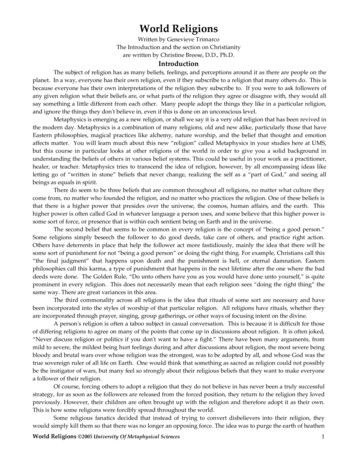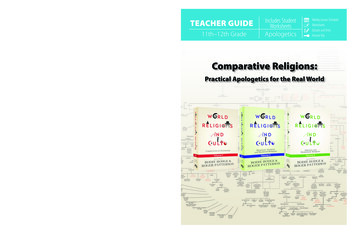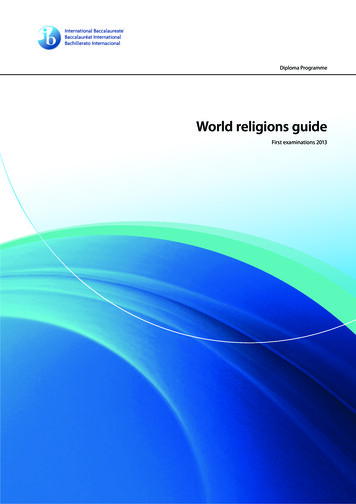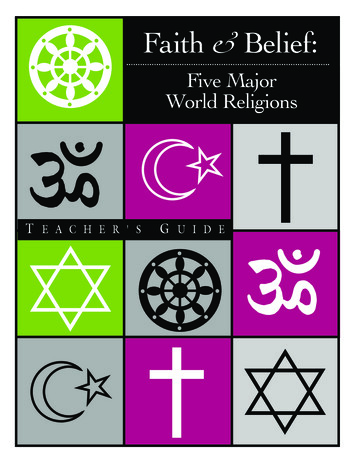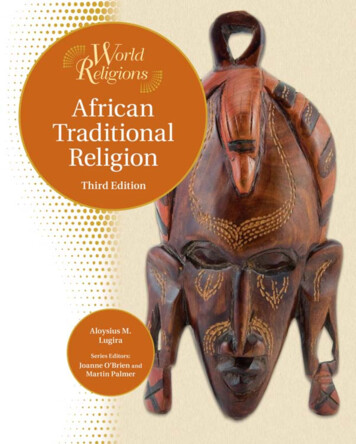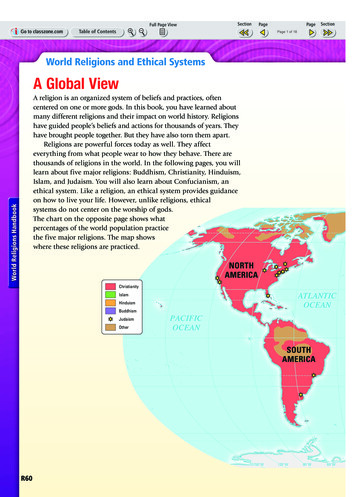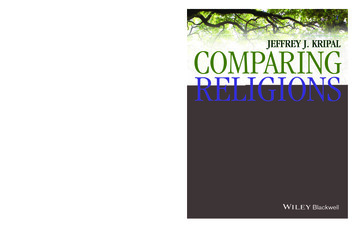
Transcription
GRADE 12World of ReligionsA CANADIAN PERSPECTIVE
Cover page illustration: Composition by Tony Tavares using iStock files 11600338,15344749, and 19752799, as well as Happy Human black.svg. November 6, 2008.Wikimedia Commons. https://commons.wikimedia.org/ wiki/File:Happy Humanblack.svg; Faravahar-BW.svg. November 11, 2008. Wikimedia Commons.https://commons.wikimedia.org/wiki/ File:Faravahar-BW.svg; and PaganReligious Symbols.png. January 13, 2011. Wikimedia Commons. https://commons.wikimedia.org/wiki/File:Pagan religious symbols.pnf.
GRADE 12World of ReligionsA CANADIAN PERSPECTIVE2019M a ni to b a Edu c at i o n a n d Tr a i ni n g
Manitoba Education and Training Cataloguing in Publication DataGrade 12 world of religions : a Canadian perspectiveIncludes bibliographical references.This resource is available in print and electronic formats.ISBN: 978-0-7711-7921-1 (pdf)ISBN: 978-0-7711-7922-8 (print)1. Religion—Study and teaching (Secondary)—Manitoba.2. Religious pluralism—Study and teaching (Secondary)—Manitoba.3. Multiculturalism—Study and teaching (Secondary)—Manitoba.4. Spirituality – Study and teaching (Secondary)—Manitoba.5. Religion and culture – Study and teaching (Secondary)—Manitoba.I. Manitoba. Manitoba Education and Training.379.28Copyright 2019, the Government of Manitoba, represented by the Minister ofEducation and Training.Manitoba Education and TrainingWinnipeg, Manitoba, CanadaEvery effort has been made to acknowledge original sources and to complywith copyright law. If cases are identified where this has not been done, pleasenotify Manitoba Education and Training. Errors or omissions will be correctedin a future edition. Sincere thanks to the authors, artists, and publishers whoallowed their original material to be used.All images found in this resource are copyright protected and should notbe extracted, accessed, or reproduced for any purpose other than for theirintended educational use in this resource.Any websites referenced in this resource are subject to change without notice.Educators are advised to preview and evaluate websites and online resourcesbefore recommending them for student use.Print copies of this resource (stock number 80748) can be purchasedfrom the Manitoba Learning Resource Centre. Order online atwww.manitobalrc.ca.This resource is available on the Manitoba Education and Trainingwebsite at www.edu.gov.mb.ca/k12/.Available in alternate formats upon request.
ContentsAcknowledgementsPurposeDelivery of the CourseIntroduction113Religious Diversity in Canada3Understanding Our History: Overcoming Intolerance and Working Towards Acceptance5Towards Religious Literacy8Difference between Teaching of Religion and Teaching about Religion10Education and Religion13Theoretical Foundations15What Is Religion?15What Are Some of the Different Approaches to Studying Religious Diversity?16Guidelines19What Approach Will We Use to Explore Religious Diversity?20Course Outline21How Do We Study Religious Diversity in a Fair, Respectful, and Non-JudgementalManner?22How Important is Inter- and Intra-Religious Diversity?22Which Religions Do We Explore?23How Do We Deal with Sensitive and/or Conflictual Ethical and Social Issues?24Essential Questions and Enduring UnderstandingsContentsvii27Overarching (Diversity of Religions):Essential Questions28Overarching (Diversity of Religions):Enduring Understandings29Religion Specific: Essential Questions31Religion Specific: Enduring Understandings31v
Suggestions for Teaching and LearningReligion Backgrounders/Profiles for Teacher Reference and Use35Developing a Respectful Classroom Community36Guidelines for Selecting Which Religious Perspectives to Study40Teaching and Assessment Tools41Selecting Learning Resources44Teaching and Learning Resources45Religious Education Guidelines45Cultural Sensitivity and Inclusive Classrooms46Dealing with Sensitive or Conflictual Ethical and Social Issues46Canada Religious Diversity Statistics and Information46World Religions—Religious Diversity Curricula47Diversity of Religion: Websites47Multifaith Calendars52Religious Diversity Texts52Resources Available from Manitoba Education Library54Examples of Teaching Units54Student Project Examples54AppendicesBibliographyWorks Citedvi35555559Grade 12 World of Religions: A Canadian Perspective
AcknowledgementsManitoba Education and Training gratefully acknowledges the contributions of the followingindividuals in the development of Grade 12 World of Religions: A Canadian Perspective.Project LeadTony TavaresInstruction, Curriculum and Assessment BranchDiversity and International Manitoba Education and TrainingLanguages ConsultantWriterTony TavaresInstruction, Curriculum and Assessment BranchDiversity and International Manitoba Education and TrainingLanguages ConsultantContributersAcknowledgementsJerome BaseleyTeacherDaniel McIntyre CollegiateWinnipeg School DivisionDarcy BayneConsultantInstruction, Curriculum and Assessment BranchManitoba Education and TrainingKevin DoerksenTeacherVincent Massey High SchoolBrandon School DivisionAnat EkhoizTeacherGray Academy of Jewish EducationJames FriesenTeacherWestgate Mennonite CollegiateRyan EvansTeacherCollège Sturgeon Heights CollegiateSt. James-Assiniboia School DivisionTyler HendrenTeacherThe King’s SchoolYvonne InnissTeacherLord Selkirk Regional ComprehensiveSecondary SchoolLord Selkirk School DivisionJayesh ManiarConsultantInstruction, Curriculum and Assessment BranchManitoba Education and TrainingJarett MyskiwTeacherWinnipeg School DivisionErin PetersTeacherOak Park High SchoolPembina Trails School DivisionMichael ZwaagstraTeacherGreen Valley SchoolHanover School Divisionvii
Advisors/Participants inConsultationSessionsManitoba Educationand Training StaffviiiLynda TronoManitoba Multifaith Council (MMC)Manju LodhaArtist/Community EducatorAtish ManiarPundit, Community MemberTara ManiarCommunity Educator, Chakra Dance Specialist,Ashram EducatorDino AltieriAssistant DirectorIndigenous Inclusion DirectorateLouise BoissonneaultCoordinatorDocument Production Services UnitInstruction, Curriculum and Assessment BranchCarolee BucklerSenior Planning AnalystPolicy Planning and PerformanceLinda ConnorConsultantLearning Support and Technology UnitInstruction, Curriculum and Assessment BranchDiane CourcellesPublications EditorDocument Production Services UnitInstruction, Curriculum and Assessment BranchJohn FinchCoordinatorLearning Support and Technology UnitInstruction, Curriculum and Assessment BranchRenée GillisConsultantBureau de l’éducation françaiseGilles LandryConsultantLearning Support and Technology UnitInstruction, Curriculum and Assessment BranchClaudette LaurieConsultantBureau de l’éducation françaiseVal NoseworthyConsultantLearning Support and Technology UnitInstruction, Curriculum and Assessment BranchAudrey NorthConsultantLearning Support and Technology UnitInstruction, Curriculum and Assessment BranchGreg PrudenConsultantEarly Childhood and Development UnitInstruction, Curriculum and Assessment BranchDonna SmithCoordinatorIndependent Education UnitInstruction, Curriculum and Assessment BranchDiana TurnerActing CoordinatorEarly Childhood and Development UnitInstruction, Curriculum and Assessment BranchLindsay WalkerDesktop PublisherDocument Production Services UnitInstruction, Curriculum and Assessment BranchShelley WarkentinConsultant(until December 2018)Early Childhood and Development UnitInstruction, Curriculum and Assessment BranchGrade 12 World of Religions: A Canadian Perspective
PurposeThis document is a resource for educators teaching the Grade 12: Worldof Religions: A Canadian Perspective optional course. Within the course,learners explore important aspects of human diversity, and develop greaterunderstanding and awareness of the historical and contemporary significanceof religious diversity in Manitoba, Canada, and the world.It is important to understand and value religious diversity while recognizingthat some aspects of diverse religions may be similar and others may beunique or different. The intent is not to put forward a reductionist view thatall religions in some way are the same or are fundamentally at odds witheach other. As a result, the curriculum proposes an approach that promotescritical dialogue. “Critical dialogue has several prerequisites. It requires mutualrespect, thoughtful listening, knowledgeable inquiry, recognition of the multidimensionality of the other’s situation, creative interaction, careful cooperationand, when appropriate, concerned confrontation.” (Erdel)The intent of religious diversity and world religions courses should not be toencourage the practice or promotion of a specific religion or spiritual beliefsystem, nor the development of religious faith. Rather, the intent should be thedevelopment of understanding and appreciation for the diversity of religiousbelief systems and practices, and their roles in society and people’s lives. Thecurrent course also aims to challenge misinformation and biases, both explicitand implicit, that learners may have developed or to which they may have beenexposed.Delivery of the CourseThis course may be delivered as a full-credit course or a half-credit course.As a half-credit course, students would explore 2–3 distinct religious traditions.Reporting CreditsTitleSubject CodeCreditsWorld of Religions060640S 1 credit, 40E 1 credit, 40M 1 creditWorld of Religions060640S 0.5 credit, 40E 0.5 credit, 40M 0.5 creditGrade 12 World of Religions: A Canadian Perspective1
IntroductionReligious Diversity in CanadaFrom the beginning, Canada has been a diverse society with a history ofwelcoming and accommodating newcomers. Historically, diversity in Canadawas built on three primary groups of peoples: Indigenous Peoples, French, andBritish. Over time, this initial diversity has been complemented and expandedby the millions of newcomers from around the world who brought withthem a diversity of cultures, languages, and religions. This trend continuestoday. Canadians are increasingly diverse in their religious perspectives andaffiliations. The charts that follow provide an overview of the past, present,and future of religious diversity in Canada.While the majority of Canadians today identify as belonging to a Christianfaith, they increasingly reflect the major religions of the world. As well,indigenous peoples increasingly identify with and practice traditionalspirituality.There are some interesting trends that should be noted, among which thefollowing:QQThe number of Canadians reporting no religious affiliation was 17% in 2011and, at that point, was expected to grow to over 21% in 2016.QQThe Muslim community is growing rapidly.QQChristianity is increasingly diverse.Grade 12 World of Religions: A Canadian Perspective3
Figure 1: Major Faith Groups in CanadaSource: Citizenship and Immigration Canada. “Annual Report on the Operation of the CanadianMulticulturalism Act 2010–2011.” 09 February 2012. Government of Canada. 02 June ion 2012/cic/Ci95-1-2011-eng.pdf.Figure 2: Cultural and Religious Diversity in Canada 2011Source: Griffitth, Andrew. “Happy Multiculturalism Day!” 27 June 2014. Multicultural Meanderings.02 June 2016, 4/06/27/happy-multiculturalism-day/.All rights reserved.4Grade 12 World of Religions: A Canadian Perspective
Understanding Our History: OvercomingIntolerance and Working Towards AcceptanceIn exploring the diversity of world religions and perspectives, it is importantto acknowledge Canada’s history of religious discrimination. For much ofCanada’s history, cultural and religious diversity was often seen as a problemto overcome. The perpetuation of diversity was not desired and there was astrong emphasis on assimilation (total assimilation of new Canadians of nonEnglish and Christian origins). These xenophobic attitudes and beliefs were, atone point, widespread throughout society.“Assimilationist ideology was applied in its most explicit and energetic formto immigrants of non-French and non-British background. All the major bookson immigration published prior to 1920, and written by progressives andreactionaries alike, (including J. S. Woodsworth’s Strangers Within Our Gates;Ralph Connor’s The Foreigner; Alfred Fitzpatrick’s Handbook for New Canadians;C. A. McGrath’s Canada’s Growth and Some Problems Affecting It; C. B. Sisson’sBilingual Schools in Canada; and W. G. Smith’s A Study in Canadian Immigration)were based on assumptions of Anglo-conformity.” (Maella, p. 63)Woodsworth was concerned about the influx of immigrants to Canada andthe potential negative effects of such immigration. He writes in the prefaceto Strangers within Our Gates, “this little book is an attempt to introduce themotley crowd of immigrants to our Canadian people and to bring beforeour young people some of the problems of the population with which wemust deal in the very near future” (Woodsworth, p. 5). He then goes on todetail what he believes to be the main challenge resulting from immigration,“English and Russians, French and Germans, Austrians and Italians, Japaneseand Hindus—a mixed multitude, they are being dumped into Canadian by akind of endless chain. They sort themselves out after a fashion, and each seeksto find a corner somewhere. But how shall we weld this heterogeneous massinto one people? That is our problem.” (Woodsworth, p. 203)J. S. Woodsworth was not against all immigration. Generally, he waswelcoming of some immigrants and acknowledged the positive aspectsof peoples of diverse languages and cultures, and their contributions (e.g.,he had positive views with respect to Jews). That being said, he argued forrestricting immigration of certain groups—those that, in his view, were fromcultures, religions, and races which made them difficult, if not impossible,to assimilate or who may even resist assimilation. Even this well-known,progressive individual and advocate for the poor and the working class didnot escape the dominant belief in Anglo-Saxon superiority and the prejudicetoward non-Christian, non-Protestant, non-European peoples and ethnicities.His fear of the emergence of ethnic and religious ghettos, and arguments forkeeping some people out of Canada is expressed in Strangers Within Our Gatesat various points.Grade 12 World of Religions: A Canadian Perspective5
Alan Mills, a well-known professor of political studies with the Universityof Winnipeg makes several observations about Woodsworth’s views onimmigration and diversity.“Woodsworth did not believe in the equality of all cultures. Because of amixture of factors—historical and environmental good fortune, geneticinheritance or cultural distinctiveness (he was unclear on this matter)—heheld that Anglo-Saxon peoples were highly civilized and superior.”(Mills, p. 107)“Finally, implicit in Woodsworth’s early account of the immigrant question is acelebration of an independent, democratic, free-hold yeomanry. He observedthat many of the immigrants to Canada before World War I had come fromareas dominated by Habsburg and Tsarist absolutism, where serfdom was stilla remembered reality. Often their religion was of a Catholic type. Such peopleembodied a condition of political, economic, and religious backwardness.They were unused to the management of farms, were deferential to authority,and politically apathetic; they had embraced a purely local perspective onthe world, were illiterate and superstitious, and thus likely to be ignorant andimmoral. To Woodsworth they were serfs and barbarians and unworthy ofinclusion in the Canadian ideal of educated, independent, Protestant, andtechnically innovative yeoman farmers.” (Mills, p. 108–109)Woodsworth himself wrote:“It is generally agreed that the two races are not likely to “mix”. Ultimately,then, the question resolves itself into the desirability of a white caste and ayellow, or black caste existing side by side, or above and below in the samecountry. We confess that the idea of a homogeneous people seems in accordwith our democratic institutions and conducive to the general welfare. Thisneed not exclude small communities of black or red or yellow peoples. It iswell to remember that we are not the only people on earth. The idealist maystill dream of a final state of development, when white and black and redand yellow shall have ceased to exist, or have become merged into someneutral gray. We may love all men yet prefer to maintain our own family life.”(Woodsworth, p. 277)“We, in Canada, have certain more or less clearly defined ideals of nationalwell-being. These ideals must never be lost sight of. Non-ideal elementsthere must be, but they should be capable of assimilation. Essentiallynon-assimilable elements are clearly detrimental to our highest nationaldevelopment, and hence should be vigorously excluded.”(Woodsworth, p. 278)6Grade 12 World of Religions: A Canadian Perspective
Woodsworth’s views on immigration remind us that while Canada is oftenseen as a historically welcoming nation that is open to immigration anddiversity, the reality is that historical records are at odds with this view. Atvarious times throughout Canada’s history, specific ethno-religious groupswere targeted and faced significant discrimination and limitations on theirrights as citizens, or were denied entry into Canada. For example,QQQQQQQQThe historical repression and prohibition of Indigenous spiritual practicesthrough the Indian ActThe denial of the right to vote for Hindus in British Columbia and laterrestrictions on immigration of Hindus and Sikhs, including the KomogataMaru incidentThe restriction of Mennonite immigration to Canada post World War Ibecause of their pacifist beliefs (Conscientious Objectors)The ‘none is too many’ approach towards Jewish immigration before andduring World War IIIt is also important to note that religious discrimination and exclusion is notjust a Canadian issue. The Pew Research Center reported that, in 2013, theshare of countries with a high or very high level of social hostilities involvingreligion had declined somewhat after having reached a six-year peak in 2012.According to the study by the Pew Research Center, “the share of countrieswith high or very high levels of social hostilities involving religion droppedfrom 33% in 2012 to 27% in 2013.” The hostilities experienced range fromvandalism of religious property and desecration of sacred texts, to violentassaults resulting in injuries and deaths. (Pew Research Center, 2015)However, the percentage of countries with high or very high governmentrestrictions on religion stayed about the same, dropping slightly from 29% in2012 to 27% in 2013. (Pew Research Center, 2015)Overall, the study found that restrictions on religion were high or very high in39% of countries when restrictions from government policies or from hostileacts by private individuals, organizations, and social groups were considered.(Pew Research Center, 2015)The Pew Research study found that “among the world’s 25 most populouscountries, the highest overall levels of restrictions were found in Burma(Myanmar), Egypt, Indonesia, Pakistan and Russia, where both thegovernment and society at large impose numerous limits on religious beliefsand practices.” (Pew Research Center, 2015)Similar to studies done in previous years, Christians and Muslims, whocollectively make up more than half of the world’s population, facedharassment in the largest number of countries. “Christians were harassed,either by government or social groups, in 102 of the 198 countries includedin the study (52%), while Muslims were harassed in 99 countries (50%).” (PewResearch Center, 2015)Grade 12 World of Religions: A Canadian Perspective7
Towards Religious LiteracyJust as reading and writing are consideredessential skills for us to survive and thrive inthis world, our knowledge of each other’sreligions is also key. When we aim to betterunderstand each other’s faiths, somethinghappens. We begin to stop essentializingeach other’s religions.(Kassamali)In recent years, the issue of religious illiteracy/literacy has come to theforefront as an example of the barriers North American societies facewith respect to inclusion and social cohesion, as well as with regard tounderstanding of and interaction within the multifaith, global village in whichwe live.Paul Bramadat, a well-known Manitoban (former professor at the Universityof Winnipeg) as well as a Canadian professor of religious studies anddiversity, argues that “the virtual exclusion of religion from public discourse(including its absence from, or awkward presence in, national ceremonies,media coverage, and in most public schools) has produced a kind of religiousilliteracy the result of which is that Canadians are increasingly ignorant aboutworld religions, including Christianity.” (Bramadat, p. 5)James Ron, a secular Jew and associate professor at the Norman PatersonSchool of International Affairs, Carleton University, as well as a former CanadaResearch Chair at McGill University, states in a 2012 editorial opinion hewrote for the Toronto Star that, in the “graduate program where I now teach,Canada’s finest global affairs students seem virtually illiterate when it comesto their own religion, or to the religions of others. Although they eagerlyachieve competence in secular politics, they express little interest in learningthe basics of Islam, Hinduism, Buddhism or Judaism.” (Ron)8Grade 12 World of Religions: A Canadian Perspective
Stephen Prothero, in his book Religious Literacy (2008), argues that the UnitedStates is one of the most religious places on earth, but it is also a nation ofshocking religious illiteracy. As evidence of this he pointed out that Only 10% of American teenagers could name all five major world religionsand 15% could not name any of them. Nearly two-thirds of Americans believed that the Bible holds the answersto all or most of life’s basic questions, yet only half of American adultscould name even one of the four gospels and most Americans could notname the first book of the Bible.(Prothero)The PEW Research Centre on Religion and Public found that atheists,agnostics, Jews, and Mormons in the United States correctly answeredbetween 20 and 21 of the Pew Forum’s 32 questions on Christianity, worldreligions, and laws governing faith in public life. In contrast, whiteevangelicals, averaged scores of only 17 questions correctly answered, whilewhite Catholics and mainline Protestants were able to answer just 16 of thequestions. (Pew Research Center, 2010)A fall 2011 poll in Canada, by Leger, foundthat people with a good knowledge of othercultures and religions were more likely tohave a high level of knowledge about theirown religious community and culture(78 per cent) while among those with littleknowledge of other religions and cultures,only 23 per cent had good knowledge oftheir own religion and culture. In addition,people familiar with other cultures andfaiths also were more likely to feel confidentinteracting with people from an unfamiliarculture (84 per cent) than people without thatknowledge (33 per cent).Diane L. Moore of the Harvard School ofDivinity, in her book Overcoming ReligiousIlliteracy: A Multicultural Approach to Teachingabout Religion in Secondary Schools, suggeststhat that there is not only widespreadreligious illiteracy in North America butacross the world. Moore believes thatone of the most problematic and urgentconsequences of this religious illiteracy isthat it often breeds and fuels prejudice andantagonism, consequently limiting effortsaimed at promoting respect for diversity,peaceful coexistence, and cooperative actionat the local, national, and global levels. (Moore)Grade 12 World of Religions: A Canadian PerspectiveFor the purposes of thisdocument, we have adoptedthe definition of religiousilliteracy as defined inGuidelines for Teachingabout Religion: In K–12 PublicSchools in the United States.“Religious illiteracy as a lackof understanding about thefollowing:the basic tenets of theworld’s religious traditionsand other religiousexpressions not categorizedby tradition;QQ the diversity of expressionsand beliefs within traditionsand representations; andQQ the profound role thatreligion plays in humansocial, cultural, and politicallife historically and today.”(Moore, 2010, p. 4)QQ9
Both Prothero and Moore believe that it is possible to address religiousilliteracy by teaching about religion from a non-sectarian and non-devotionalapproach in primary and secondary schools.Moore defines religious literacy to be the ability to recognize and analyze thefundamental intersections of religion and social, political, and cultural life“through multiple lenses.” Moore’s concept of a religiously literate person isone who possesses1.a basic understanding of the history, central texts (where applicable), beliefs,practices, and current manifestations of several of the world’s religioustraditions as they grew out of and continue to be shaped by particular social,historical, and cultural contexts2.the ability to recognize and explore the religious dimensions of political,social, and cultural expressions across time and placeMoore’s definitions assume that religion is a socio-cultural phenomenon thatis embedded in human political, social, and cultural life. They also assumethat religion shapes and is shaped by the social and historical contexts out ofwhich a particular religious expression or tradition and its influences emerged.Lastly, these definitions presuppose that there is a difference betweenreligion understood through the lens of personal devotional practice andthe academic or non-sectarian study of religion. In other words, one is aboutreligious learning (or learning religion) through a devotional lens and the otheris learning about religion from an academic and non-devotional stance. Whileboth are legitimate human activities, they serve complementary but distinctiveends.Difference between Teaching of Religion andTeaching about ReligionWhile there are long, historical ties to religion within the context of educationin Manitoba, most have been of a strictly theological or participatory nature.That is, there has been historically less teaching about religion than teachingof religion. With that in mind, any educational resource package that touchesupon religion is bound to raise concerns among educators, students, andcommunity members. What follows are specific concerns or problems in thedesign of such a program, and suggestions for their amelioration with regardto the Canadian Charter of Rights and Freedom and the provincial educationalmandates.QQ10Concerns over proselytization: One of the most significant concernsover the inclusion of religion in public school curriculum is whethersaid materials operate either overtly or covertly to promote a particularreligious ideology. The matter is not as simple as granting equal time toeach tradition, but also involves equipping educators to effectively includetraditions with which they (and students) may not be familiar. At the sametime, humanistic, secular, and atheistic perspectives also cannot be ignored.Grade 12 World of Religions: A Canadian Perspective
QQAdditional concerns: The study of religion is often tightly linked toinstruction in particularistic moral values held by dominant socio-culturalgroups. What is proposed instead is an examination of how various groupsrespond to the (near-) universal existential questions that are not answerablefrom a strictly scientific perspective. Moral values, when discussed, wouldbe more equitably framed in terms of citizenship and community, ratherthan their restriction to individual faith communities.Religious literacy is, at its core, teaching about world religions and exploringreligious diversity, and not teaching of religion (religious education,indoctrination, or devotion). The differences between teaching about religionin contrast with teaching of religion are as follows:QQQQQQQQQQQQThe approach and objectives are academic, not devotional.The programming strives to build student awareness of the diversity ofreligions, but does not encourage or expect student personal acceptance ofany religion.The focus of the programming is to study about religion, not to practice thereligion.The programming exposes students to a diversity of religious views, but doesnot impose any particular view.The programming focuses on educating about religious diversity/allreligions; it does not promote or disparage any religion.The programming may inform the student about religious beliefs, but shouldnot seek to have students conform to any particular belief.Educational, Cultural, and Individual BenefitsThe primary impetus behind including religious diversity in educationaldialogues is that it can, when implemented carefully and from a goodpedagogical foundation, help provide students with a more comprehensiveeducational experience. At a wider social level, well-educated, well-roundedstudents promote increased social integration and the development of genuinedemocratic processes.At the broad educational level, discussions of religious diversity allow studentsto develop a better understanding of human history and societies, of literarydevelopments and movements, and of philosophy and life-practice. Ignoringreligion unnecessarily restricts students’ ability to participate meaningfully inlocal and national cultural dialogues and to interact positively and respectfullywith each other. Religion continues to influence contemporary peoples,cultures, and societies, whether directly or indirectly. A basic fluency in termsof religious diversity allows individuals to more fully appreciate the nature ofthese influences.Grade 12 World of Religions: A Canadian Perspective11
While Canada is widely viewed as a pluralistic and welcoming society, itwould be willfully ignorant to suppose that discrim
Grade 12 World of Religions: A Canadian Perspective 1 Purpose This document is a resource for educators teaching the Grade 12: World of Religions: A Canadian Perspective optional course. Within the course, learners explore
